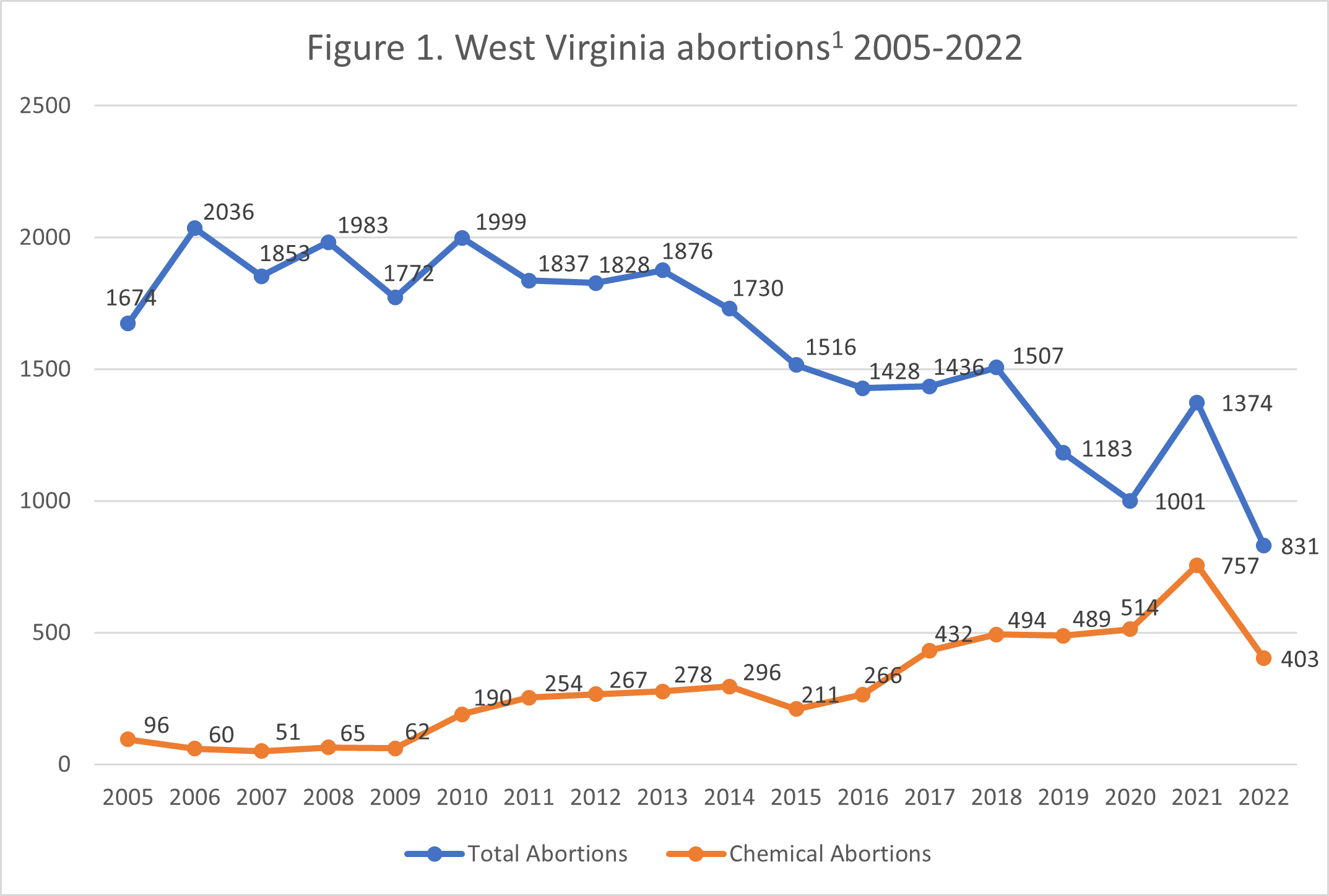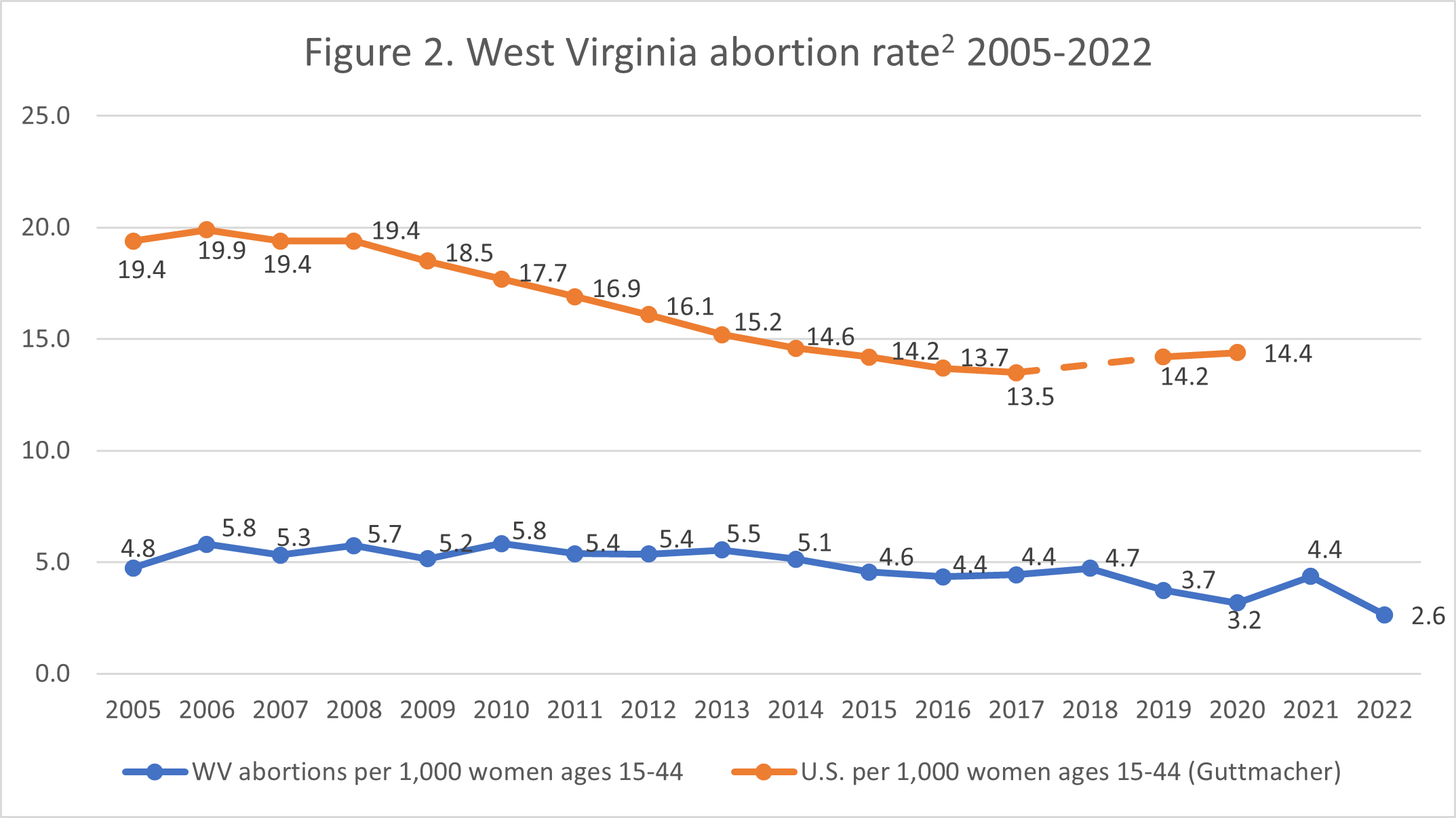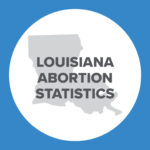Abortion Reporting: West Virginia (2022)
West Virginia’s 2022 abortion statistics were published in June 2023 via their Induced Termination of Pregnancy (ITOP) report, showing that abortions in the Mountain State have decreased dramatically since 2021.
Statistics and Changes in West Virginia Abortions, 2021-2022

The report does not include information on Planned Parenthood’s West Virginia abortion market share, but Planned Parenthood operates no abortion centers in West Virginia.
Abortion Totals and Trends
In 2022, there were 831 abortions reported in West Virginia, a decrease of 40 percent from the previous year (Fig. 1). There was a drop of 47 percent in chemical abortions between 2021 (757 chemical abortions) and 2022 (403 chemical abortions). Chemical abortions made up 48 percent of the total in 2022 (Fig. 1). The Charlotte Lozier Institute (CLI) estimates that West Virginia’s abortion rate in 2022 was 2.6 abortions per 1,000 women ages 15 to 44, down 40 percent from 2021 (Fig. 2). As of July 2023, 12 states have released 2022 abortion statistics, three of which reported that abortions had decreased from the previous year.
State Report Summary
In 2022, 78 percent of the abortions performed in West Virginia were on state residents and 22 percent were on women from other states. Abortions performed in West Virginia on non-residents were performed on residents of Ohio (103 abortions), Kentucky (64), Pennsylvania (seven), Tennessee, Texas, and Virginia (two each), and Kansas (one). Thirty-two percent of the abortions were performed on women ages 20-24, 28 percent on women ages 25-29, and 18 percent on women ages 30-34. Eleven percent were performed on girls ages 15-19 and seven percent on women ages 35-39. Three percent of West Virginia abortions were performed on women over the age of 40. Two abortions were performed on girls younger than 15 years old and one abortion was performed on a woman of an unknown age.
Sixty-five percent of the abortions reported in West Virginia in 2022 were performed at eight weeks gestation or earlier. Eighteen percent occurred between nine and 10 weeks, and 10 percent were performed between 11 and 12 weeks of gestation. Six percent were performed between 13 and 15 weeks, and one percent were performed between 16 and 19 weeks. There were zero abortions at 20 weeks of gestation or later and two abortions at unknown gestational ages.
In 2022, just over half (51 percent) of West Virginia abortions were performed using dilation and curettage and 48 percent were chemical abortions. There was one dilation and evacuation procedure and one abortion performed by an unspecified surgical method. Ninety-nine percent of West Virginia’s 2022 abortions were “self-paid” while seven were paid for with private insurance and four were paid for using Medicaid.
West Virginia’s 2022 ITOP report contains no information on the race, marital status, or pregnancy history of those who obtained abortions in the state, but some of this information is available in the state’s full vital statistics report, the most recent of which is the 2020 report published in March 2023. In 2020, 81 percent of West Virginia abortions were performed on unmarried women, while 19 percent were on married women. Thirty-two percent were obtained by women with no prior live births, and 64 percent were performed on women with no previous abortions.
West Virginia publishes information on its informed consent process in a separate report, per W. Va. Code §16-2I-2. The most recent report is for 2021, according to which there were 1,374 abortions reported in the state. The forms showed that all 1,374 women who received abortions received the patient counseling and informational guidance required under the state’s Women’s Right to Know Act. The report also revealed that 99.6 percent of the abortions that occurred in West Virginia in 2021 were elective and 0.4 percent were due to medical emergencies. House Bill 302, passed in 2022 and described below, superseded the Women’s Right to Know Act, but the West Virginia Department of Health and Human Resources fulfilled its existing reporting requirements before the bill’s passage.
Legislative Changes and Subsequent 2022 Quarter Four Numbers
West Virginia has published separate reports with 2019, 2020, and 2021 data collected as required by the state’s Pain-Capable Unborn Child Protection Act. This law, passed in 2015, limited abortion at 22 weeks gestation, except to save a woman’s life or a major bodily function, or in cases in which the unborn baby had a medical condition that the physician deemed would prevent the unborn child from surviving outside the womb. However, in September 2022, the state passed House Bill 302 (HB 302) which changed the state’s abortion reporting law, §16-5-22. This legislation required that each abortion performed in West Virginia be reported to the states by the 10th day of the month following the abortion, and that this information be compiled into quarterly reports to the state’s Legislative Oversight Commission on Health and Human Resources Accountability.
The same legislation that changed the state’s abortion reporting law also protects life throughout pregnancy except in the cases of sexual assault and incest, when the pregnancy is ectopic, when the unborn child is nonviable, or when the life or physical health of the mother is endangered by the pregnancy. While a medical indication for separating a mother and her baby is not the same as an induced abortion, which aims to end the life of the unborn child, the state’s law explicitly allows intervention for the aforementioned exceptions. The sexual assault and incest exceptions only apply to pregnancies within the first eight weeks gestation and within the first 14 weeks for minors. This law was passed after West Virginia’s pre-Roe legislation to limit abortion was blocked from enforcement in July 2022. In response, West Virginia’s sole abortion center, Women’s Health Center of West Virginia, immediately suspended abortions.
The 2022 ITOP report contains sections on monthly abortion occurrence data and quarter four abortion occurrences in the state (quarter four includes all abortions after September 13, 2022). A table from the report containing that data is reproduced below.
Table 1- 2022 Monthly Abortion Occurrence Data in West Virginia
| Month | # of ab. Occurring in West Virginia |
| January | 98 |
| February | 126 |
| March | 157 |
| April | 85 |
| May | 116 |
| June | 109 |
| July | 32 |
| August | 79 |
| September | 23 |
| October | 3 |
| November | 2 |
| December | 1 |
This data strongly suggests that HB 302 had a positive impact on preventing abortions in the state. According to the 2022 report, the last elective abortion reported in West Virginia was performed on September 8, 2022. Following HB 302 going into effect on September 13 through the end of the year, however, a total of six abortions were performed, all under the “exceptions” laid out in the law. Three of the six abortions were performed on women with non-medically viable, ectopic pregnancies. The other three abortions were reported under the exception that the pregnancies threatened the mothers’ lives. One mother had an ectopic pregnancy, one had uncontrolled obstetric hemorrhage, and one had advanced malignancy.
Three of the six abortions were paid for through private insurance and three were funded by Medicaid. Five of the six abortions were obtained by West Virginia residents, and one obtained by a Kansas resident. Two of the six were performed on women ages 20 to 24, two on women ages 25 to 29, and two on women ages 30 to 34. Four of the abortions performed in quarter four were on women with pregnancies at eight weeks gestation or earlier and two on women with pregnancies of unknown gestational ages. Lastly, four abortions were chemical abortions, one was a dilation and curettage abortion, and one was labeled as “surgical other.”
Given the change in reporting laws, quarter one (January-March) 2023 data is also available. During that period, four abortions were performed in West Virginia. One of the abortions was performed because the unborn child was non-medically viable due to an ectopic pregnancy, one because the woman had a severe/life threatening condition (chorioamnionitis/prematurity), and two because the unborn children had congenital anomalies (a lethal bladder obstruction and trisomy 13). CLI will provide a full report on 2023 data when it is released in 2024.
State Ranking
In 2016, CLI analyzed abortion reporting across the 50 states, the District of Columbia, and New York City. West Virginia tied for 21st best. The state has improved its reporting since then, most recently with the quarterly report requirement. The 2022 abortion report includes age of the mother, payment, residence, and monthly data unlike previous years’ reports. To further improve its reporting, West Virginia could release a full report that includes both the information that it publishes in its annual abortion report and the information the state reports to the CDC. Additionally, West Virginia could collect and report data on complications caused by abortion, as many other states do. This data is increasingly important as the distribution of abortion pills associated with higher complications rates for women rises.


- Total and chemical abortions for 2005-2015 were taken from CDC surveillance reports. Totals for 2016-2020 were taken from West Virginia’s 2020 abortion report.
- National rates were obtained from the Guttmacher Institute. West Virginia rates were calculated by CLI using the following formula: (total number of abortions performed in West Virginia ÷ number of resident women ages 15-44) x 1,000. Rates may differ slightly from previous CLI articles due to revised population estimates. Population estimates were obtained from the CDC WONDER database. Estimates for 2005-2009 are intercensal estimates of the July 1 resident population. Estimates for 2010-2019 are Vintage 2020 postcensal estimates of the July 1 resident population. Estimates for 2020-2022 are Vintage 2021 postcensal estimates of the July 1 resident population as the 2022 population estimates have not yet been released by the CDC. Estimates were produced by the U.S. Census Bureau and the National Center for Health Statistics.



























